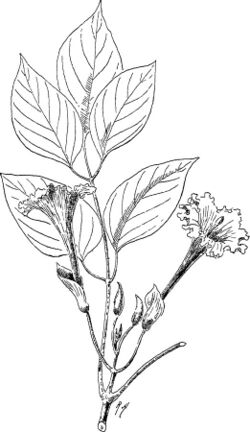Biology:Dolichandrone spathacea
| Dolichandrone spathacea | |
|---|---|

| |
| Scientific classification | |
| Kingdom: | Plantae |
| Clade: | Tracheophytes |
| Clade: | Angiosperms |
| Clade: | Eudicots |
| Clade: | Asterids |
| Order: | Lamiales |
| Family: | Bignoniaceae |
| Genus: | Dolichandrone |
| Species: | D. spathacea
|
| Binomial name | |
| Dolichandrone spathacea (L.f.) Seem.
| |
| Synonyms[1] | |
| |
Dolichandrone spathacea, also known as tui[2] or mangrove trumpet tree[3] (Thai: แคทะเล or แคป่า, khae thale or khae pa; Tagalog: tui, tue or tuy), is a species of plant in the family Bignoniaceae. It is found from South India, Sri Lanka to New Caledonia.[2]
Cultural significance
In Sri Lanka, it is known as "දිය දග - diya daga" in Sinhala.
In Southeast Asia, the leaves and barks of the Dolichandrone spathacea are used as traditional herbal medicine which is used to treat bacterial infections such as oral thrush, bronchitis, and gastrointestinal diseases.[4]
The flower is edible and it is part of Thai cuisine, where it is known as Dok Khae Thale or Dok Khae Pa,[5] being sometimes confused with Markhamia stipulata —also having the alternative name แคป่า Dok Khae Pa in Thai. The Dolichandrone spathacea flower, however, is white and not yellowish or red and looks thinner. It is usually eaten sauteed or in Kaeng som.
See also
- Markhamia stipulata, also known as แคป่า khae pa in Thai
- Sesbania grandiflora, known as ดอกแค khae in Thai
- Edible flowers
- List of Thai ingredients
References
- ↑ The Plant List: A Working List of All Plant Species, http://www.theplantlist.org/tpl1.1/record/kew-320759, retrieved 18 September 2016
- ↑ 2.0 2.1 Guide to the mangroves of Singapore
- ↑ Flowers of India, https://www.flowersofindia.net/catalog/slides/Mangrove%20Trumpet%20Tree.html, retrieved 11 February 2017
- ↑ Nguyen, P.-D., Abedini, A., Gangloff, S. C., & Lavaud, C. (2018). Antimicrobial Constituents from Leaves of Dolichandrone spathacea and Their Relevance to Traditional Use. Planta Medica International Open, 5(1), e14–e23. https://doi.org/10.1055/s-0043-125339]
- ↑ ลวกดอกแคป่า ยอดดอกโนกินกับแจ้วเห็ดเฟียง - Cooking Dok khae Pa
External links
Wikidata ☰ Q2679494 entry
 |

